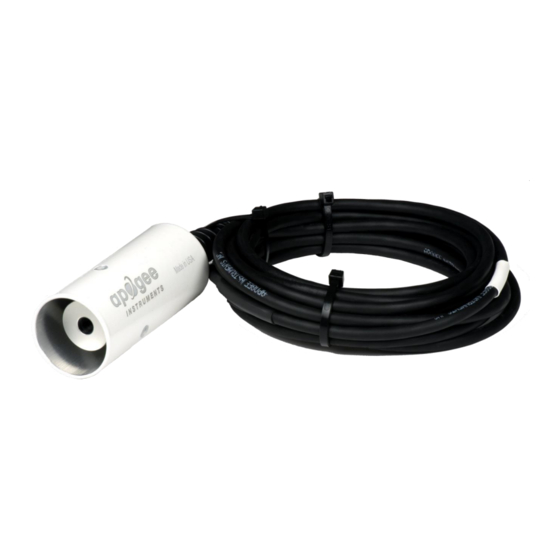Apogee SI-4H1 Panduan Pemilik - Halaman 16
Jelajahi secara online atau unduh pdf Panduan Pemilik untuk Alat Ukur Apogee SI-4H1. Apogee SI-4H1 20 halaman. Infrared radiometer
Juga untuk Apogee SI-4H1: Panduan Pemilik (20 halaman), Panduan Pemilik (20 halaman)

During the calibration process, m and b are determined at each detector temperature set point (10 C increments
across a -15 C to 45 C range) by plotting measurements of T
then plotted as function of T
determine m and b at any T
2
m
C
2
T
C
D
2
b
C
2
T
C
D
Where C2, C1, and C0 are the custom calibration coefficients listed on the calibration certificate (shown above)
that comes with each SI-100 series radiometer (there are two sets of polynomial coefficients, one set for m and
one set for b). Note that T
273.15) before m and b are plotted versus T
To make measurements of target temperatures, Eq. (1) is rearranged to solve for T
T
are input, and predicted values of m and b are input:
D
4
T
T
m
S
T
D
Emissivity Correction
Appropriate correction for surface emissivity is required for accurate surface temperature measurements. The
simple (and commonly made) emissivity correction, dividing measured temperature by surface emissivity, is
incorrect because it does not account for reflected infrared radiation.
The radiation detected by an infrared radiometer includes two components: 1. radiation directly emitted by the
target surface, and 2. reflected radiation from the background. The second component is often neglected. The
magnitude of the two components in the total radiation detected by the radiometer is estimated using the
emissivity (ε) and reflectivity (1 - ε) of the target surface:
E
E
Sensor
T
arg
where E
is radiance [W m
Sensor
target surface, E
is radiance [W m
Background
the background is generally the sky), and ε is the ratio of non-blackbody radiation emission (actual radiation
emission) to blackbody radiation emission at the same temperature (theoretical maximum for radiation emission).
Unless the target surface is a blackbody (ε = 1; emits and absorbs the theoretical maximum amount of energy
based on temperature), E
Since temperature, rather than energy, is the desired quantity, Eq. (1) can be written in terms of temperature
using the Stefan-Boltzmann Law, E = σT
absolute temperature):
4
T
Sensor
and second order polynomials are fitted to the results to produce equations that
D
:
D
1
T
C
0
D
(2)
1
T
C
0
D
(3)
is converted from Kelvin to Celsius (temperature in C equals temperature in K minus
D
.
D
1
b
273
.
15
(4)
4
D
1
E
et
Background
-2
-1
sr
] detected by the radiometer, E
-2
-1
sr
] emitted by the background (when the target surface is outdoors
will include a fraction (1 – ε) of reflected radiation from the background.
sensor
4
(relates energy being emitted by an object to the fourth power of its
4
T
1
T
T
arg
et
Background
– T
4
4
versus mV. The derived m and b coefficients are
T
D
(1)
is radiance [W m
Target
4
(2)
[C], measured values of S
T
-2
-1
sr
] emitted by the
and
D
